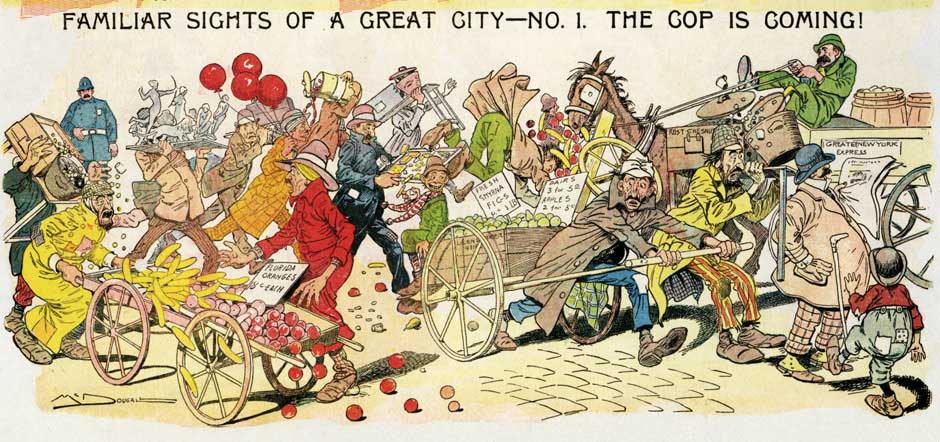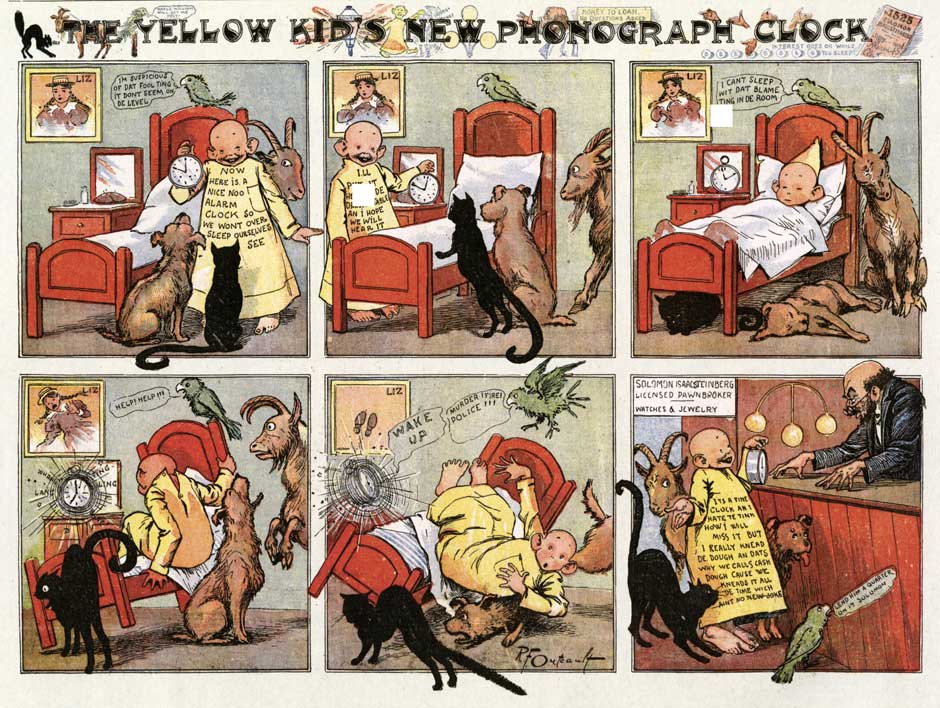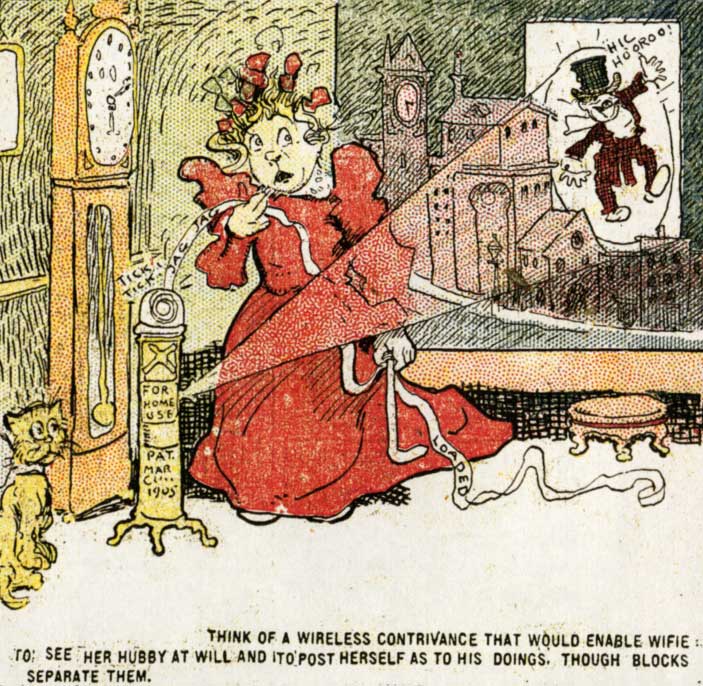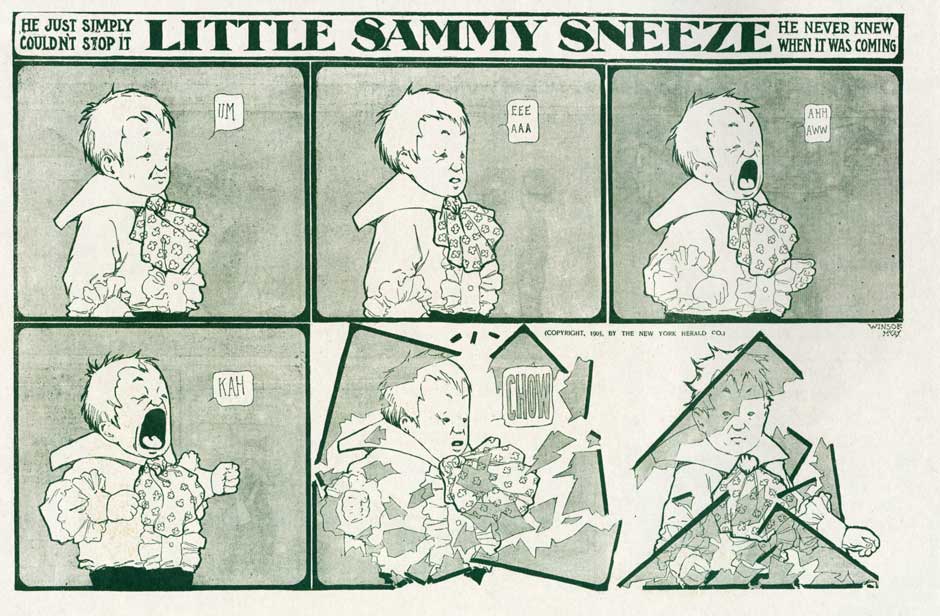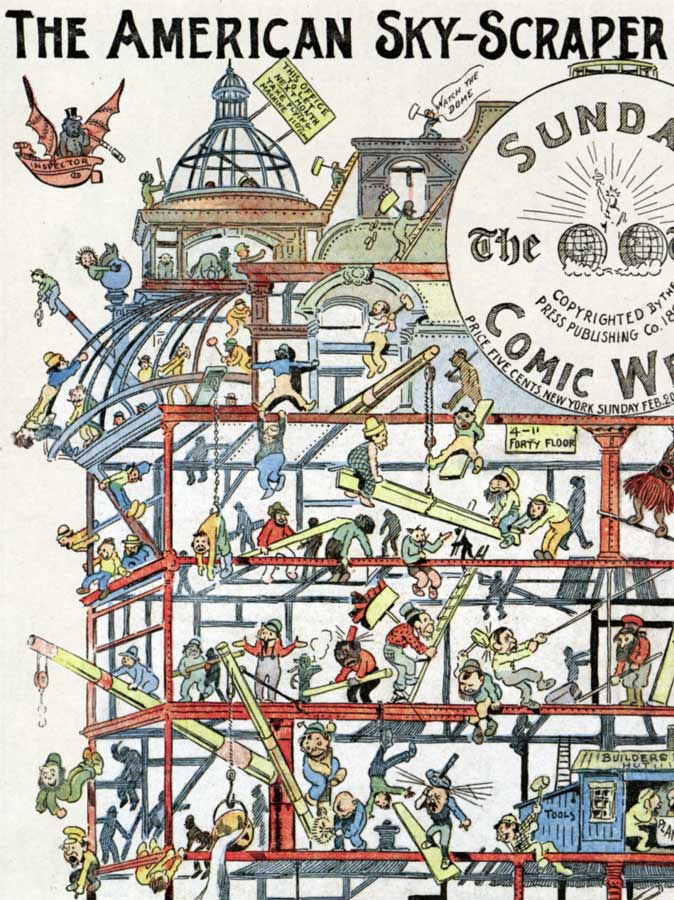On October 18, 1896, newspaper magnate William Randolph Hearst went to war—not with Spain in Cuba but with Joseph Pulitzer in New York. His opening salvo was The New York Journal’s five-cent color supplement, The American Humorist, which Hearst called “eight pages of iridescent polychromous effulgence that makes the rainbow look like a piece of lead pipe.”
The sudden explosion of color comics had been facilitated by new high-speed four-color printing presses, but “lead pipe” may have been the operative term in Hearst’s boast. The original comics were designed to stun—both their startling graphics and their rambunctious antics. “Mit dose kids, society is nix!” an adult character says of Hans and Fritz, the daemonic, chortling child protagonists of The Katzenjammer Kids which, although inspired by the German artist Wilhelm Busch’s humorous picture book Max und Moritz, may be considered America’s first fully realized comic strip.
Borrowing that line for its title, Peter Maresca’s outsized and outlandish anthology Society is Nix: Gleeful Anarchy at the Dawn of the American Comic Strip, 1895–1915, shows just how sensational this newspaper art form was in its early years. The comics were the high-tech weapon of the great newspaper circulation war and tumult, if not violence, was the new medium’s stock-in-trade. The term “yellow journalism” itself derived from the first comic-strip star, a denizen of the teeming, single-image slum tableaux Hogan’s Alley, who became known as the Yellow Kid. This jug-eared, barefoot urchin, draped in a canary-colored nightshirt, was created by thirty-three-year-old magazine artist Richard Felton Outcault at Pulitzer’s New York World; he was soon poached by Hearst for his supplement’s first issue.
Society is Nix is itself disruptive. An unwieldy sixteen by twenty-one inches, it’s a tome that’s impossible to shelve, a coffee table book that doesn’t leave much room for a cup of java. It echoes the format of the broadsheet newspapers in which the comics first appeared and, as such, allows the reader to luxuriate in the full dimensions of these throwaway images (which, thanks to another new technology, are not in the least yellow but have been digitally restored to approximate their original hues). Ephemera has seldom had such physical heft.
Maresca’s Sunday Press Books has made a specialty of such high-quality large format comic reprints, with Society is Nix the fifth one it has published since 2005. Two previous ones are devoted to the series generally acknowledged to be the early newspapers’s greatest: Winsor McCay’s Little Nemo in Slumberland and the Gasoline Alley Sunday pages. Another one, Forgotten Fantasy, is, like Society is Nix, an anthology. But while Forgotten Fantasy skewed towards romantic dreamscapes, Society is Nix focuses on the depiction of then-contemporary metropolitan life.
In addition to Hogan’s Alley and other metropolitan jungles, the comics reveled in the quotidian chaos of the urban scene: the pushcart madness of “Familiar Sights of a Great City—No. 1, The Cop is Coming” is rendered as a mock-classical frieze. Genuine monuments are regarded with derision; several strips in Society is Nix satirize the rapid transit system then under construction in New York. As the twentieth century approached, cartoonists extrapolated a city of the future, replete with snow-capped office buildings, floating real-estate agents, and colliding single-person dirigibles, or ponder “the possibilities of wireless telegraphy” which, save for predicting communication with Mars, seems much like the Internet. (On the other hand, one proto-Flintstones strip transposes the automobile back onto the Pleistocene.)
Two of the most remarkable pieces in Society is Nix merge comic strip format with urban architecture. Tremendously dense, “The American Sky-Scraper is a Modern Tower of Babel” (published in the World in 1898) uses a multi-story construction site as the stage for several dozen ethnic conflicts, many involving the building’s different levels; scarcely less riotous, “Life in the Wrangle Flats” (which appeared two years later), is a tenement cross-section that identifies the borders of its panels with the building’s floors, ceilings, and walls.
In his introduction, Maresca refers to these comic strips as “the birth of modern popular culture”—perhaps “mass media” would be a better term. These strips were not only all over the page, they were in big cities all over the country—the most successful supplements reached hundreds of thousands of readers in New York alone. Yet at the same time, they were wildly experimental. The comics satirized each other and their artists often jammed together—their characters making guest appearances in each others’ strips. In 1894, the New York World drolly translated the paper’s stock gags and characters into Egyptian hieroglyphics. Rather than draw a strip, one Chicago Tribune artist fashioned sequential clay relief sculptures and photographed them.
Advertisement
Some stories had panoramic panels that predicted CinemaScope; others nested panels one inside the other. Under the rubric “In Nature’s Fun Shop,” a trio of World artists packed three separate stories into one page, using an ingenious jigsaw puzzle structure that allowed them to be read simultaneously. Even more convoluted was the short-lived Chicago Tribune feature Crazy Quilt, in which a half dozen artists intertwined their stories, developing a layout with complexity that, McCay aside, would not been seen again until the recent work of Chris Ware. (McCay is largely absent from this volume, although the first of his two inclusions is a typically elegant and self-reflexive gag that has the eponymous protagonist of Little Sammy Sneeze shattering the panels of his strip with his titanic ker-choo.)
As befits a youthful medium, the strips specialized in kids running wild. Amply represented here, the medium’s three key figures—Richard Felton Outcault, Rudolph Dirks, and James Swinnerton—all created such characters. Outcault, the Paris-trained draughtsman who first set newsprint aflame, followed the Yellow Kid with the slapstick clutter of Kelly’s Kindergarten, and the more circumspect and privileged, but nonetheless prankish, Buster Brown. Swinnerton was a graduate of the California School of Design in San Francisco who went to work for Hearst’s San Francisco Examiner while still in his teens; his first strip, Little Bears and Tigers, featured funny animals, and in 1905 he invented the wide-eyed, somewhat anxious Little Jimmy, lost in the space of an adult world. And the self-taught Dirks, who immigrated as a child from Schleswig-Holstein to Chicago, was responsible for the perpetual mischief machine of The Katzenjammer Kids.
It was The Katzenjammer Kids, introduced in The New York Journal in December, 1897, that more or less brought the American comic strip to fruition. Over time, Dirks began employing regular dialogue balloons (the better to deliver the strip’s stage German dialect) and establishing a rough-and-tumble comic rhythm, in which the irrepressible Kids hatch a plan and orchestrate havoc to wind up spanked and bawling by their mountainous mother and her equally formidable paramour, the Captain. (Something of a katzenjammer himself, H.L. Mencken supposedly clipped the strip and pasted the characters onto the floral wallpaper in his Baltimore townhouse.)
The Katzenjammers required barely three months to displace the Yellow Kid as the Journal’s star attraction—witness the first page of the papers March 27, 1898 comic supplement, with gleeful Hans and Fritz disguised as the Yellow Kid and his girlfriend Liz, triumphantly marching through an Irish slum where the street signs now read “Hoch Erin!” and “Germany Go Bragh.”
Although replete with racial and ethnic stereotypes, the first newspaper comic strips were not so much an extension of vaudeville as precursors of the equally déclassé and temperamentally anti-authoritarian motion picture. The early strips thrived on choreographed violence, including runaway horse carts, baroque streetcar collisions, and a panoply of what Hearst might have termed polychromous explosions.
American cinema fully came into its own as an expressive theater of cruelty when Mack Sennett applied the speed and violence of D.W. Griffith’s montage to the rowdy Katzenjammer mise-en-scene. It would take the movies a dozen years or more to equal the noiseless din of a strip like “The Katzenjammers Celebrate Christmas” (1902), in which the kids use a fire extinguisher to provoke a brutal fight among the tree-trimming adults (“ach, der merry yule-tide”), complete with visiting innocent Happy Hooligan clobbered by a handy cop.
Nor is this desecration the only Christmas travesty to be found in Society is Nix. Were Americans less sentimental or defensive a hundred years ago than they are today? The best of these strips produce a visual ruckus that, if one takes a moment to reflect on what’s actually supposed to be happening, is unequaled even now. In the world of the comics, every day was July 4th and every night New Year’s Eve.
Society is Nix: Gleeful Anarchy at the Dawn of the American Comic Strip, 1895–1915 is published by Sunday Press Books.


